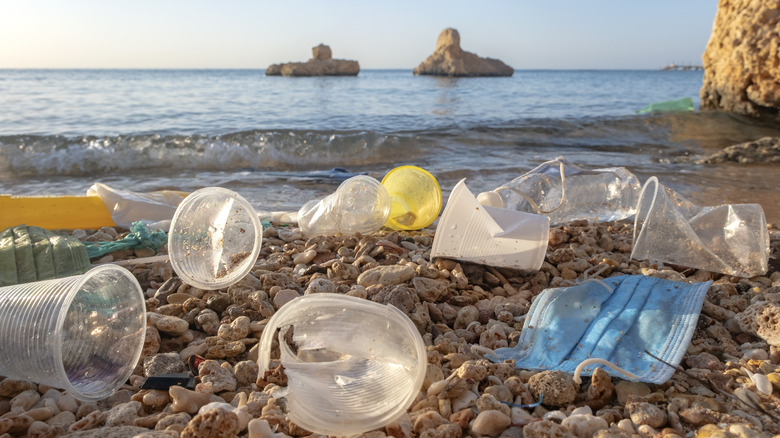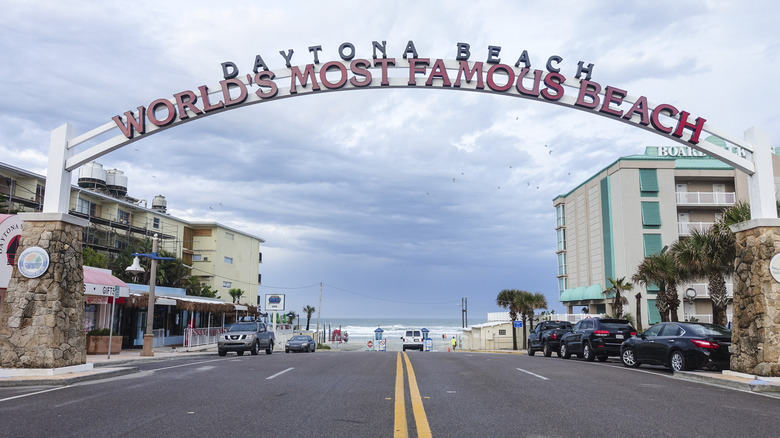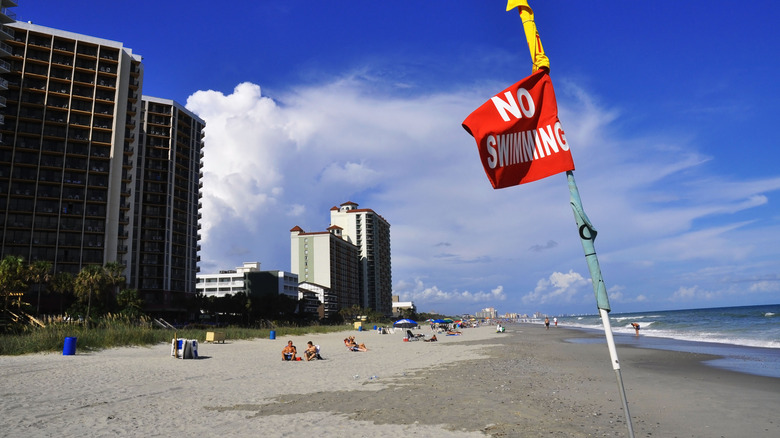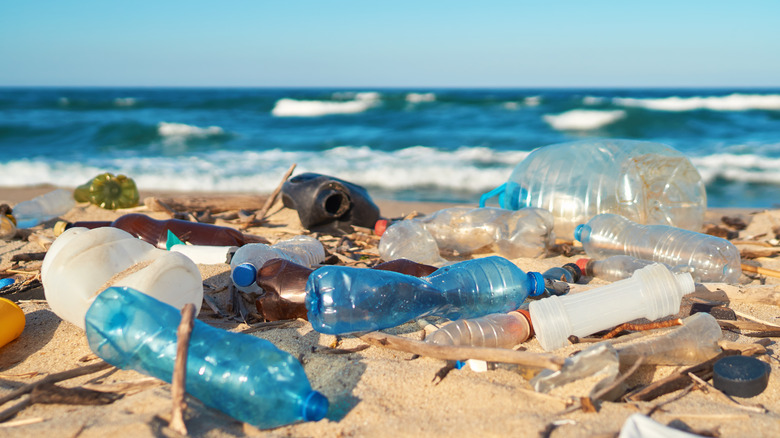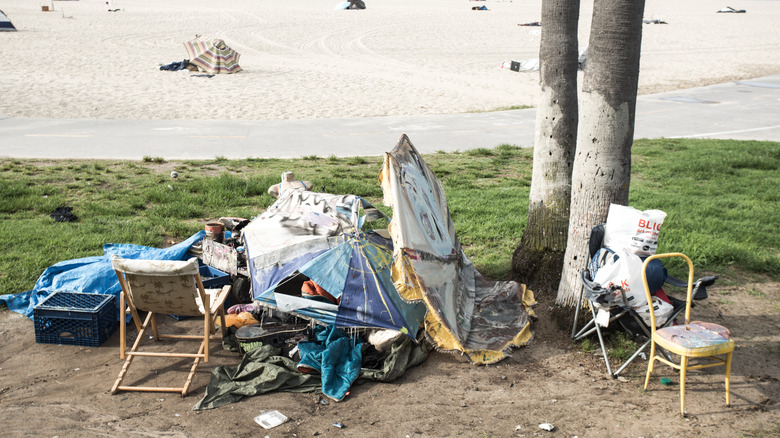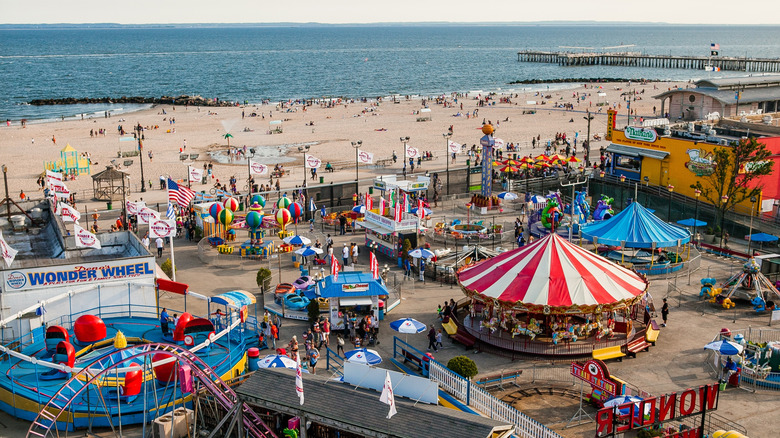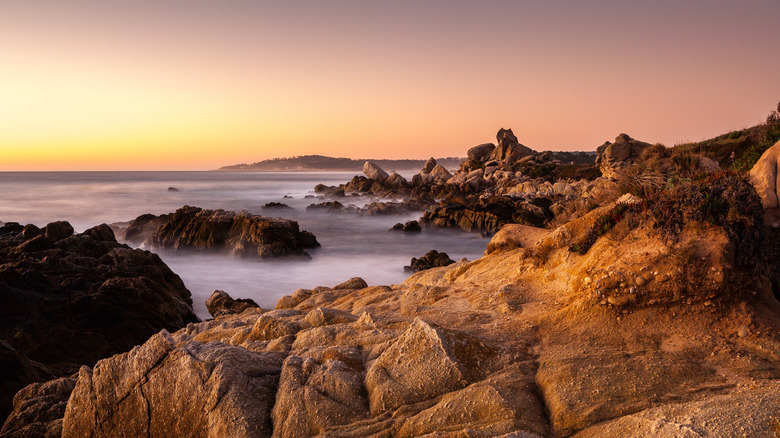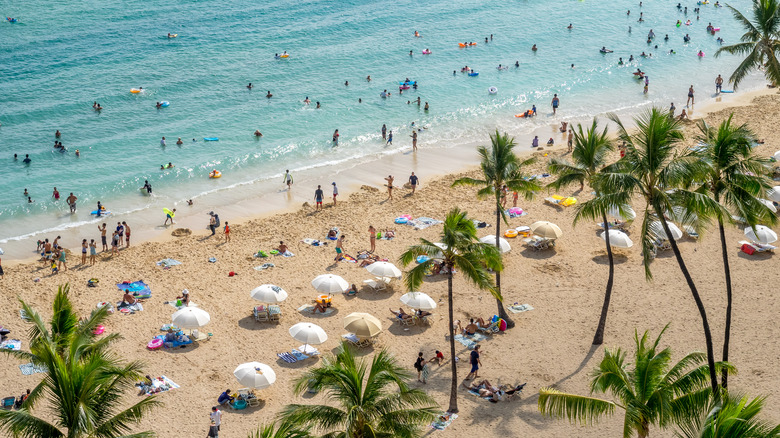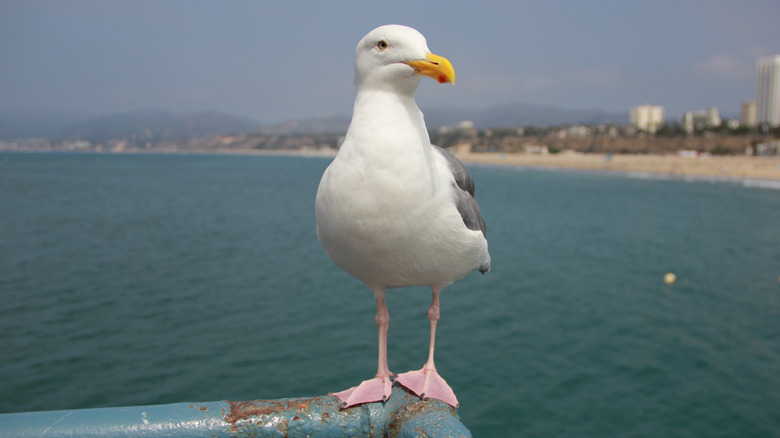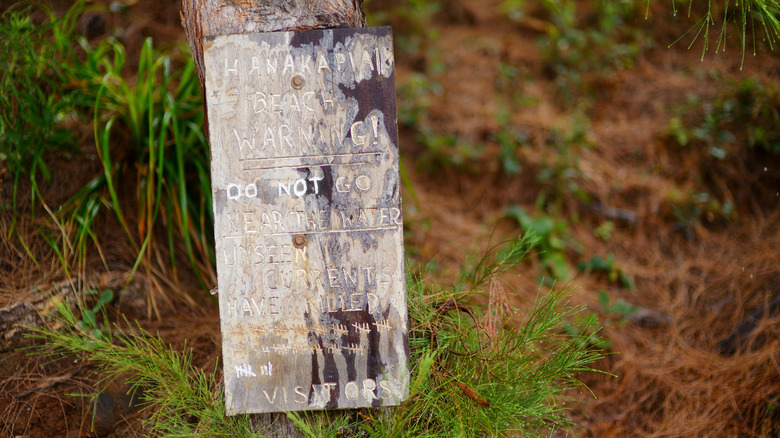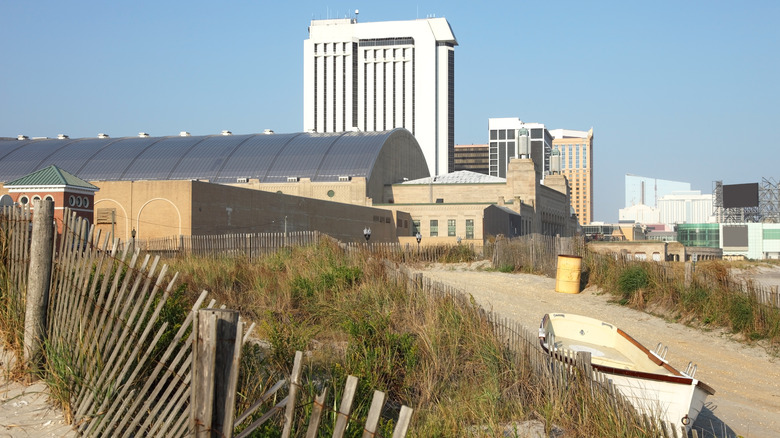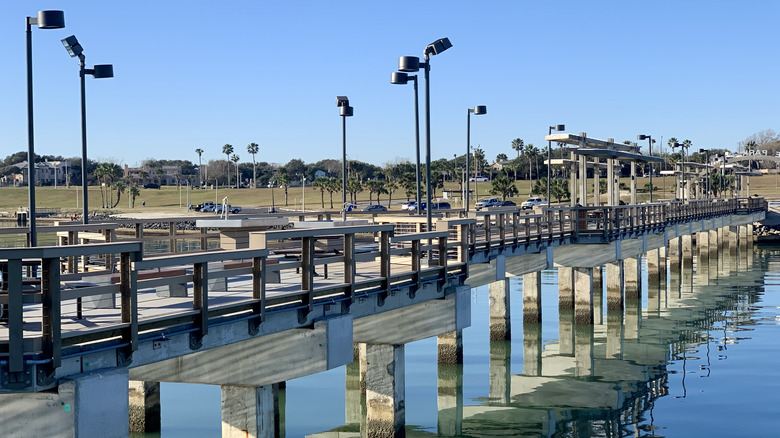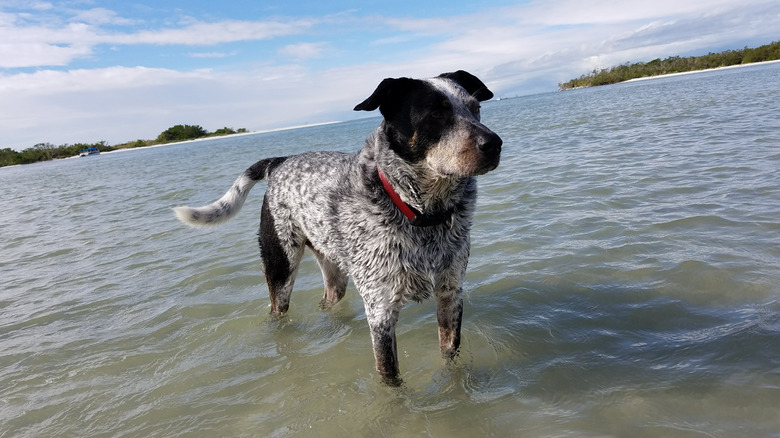The Worst US Beaches In 2023
When it comes to beaches, everyone has different standards. Some of us like our beaches to be remote, windswept, and mostly devoid of people. Some of us just want the water to be a pleasant temperature. Others prefer a beach without litter or toxic chemicals. Still, others just don't want to get eaten by a shark. No matter what your own personal preferences are, though, there are a few American beaches that everyone should avoid because they're terrible in so, so many ways.
To compile this list, we used a combination of environmental reports, "don't go there" warnings from popular travel sites, visitor reviews, and common sense. But it is worth noting that a lot of marginally bad beaches did not make this list, and some beaches just barely missed being added to the list because they don't happen to have as much pollution at this very moment. The beaches that made it on this list? Well, they're pretty inexcusably bad. Here are the beaches you really, really need to stay away from in 2023.
Daytona Beach, Florida
When it's completely devoid of people and the sun is setting — which never really happens except in promotional photographs — Daytona Beach, Florida is actually quite lovely. But if you look under the idyllic facade, you won't find much to like about this beach. For a start, sharks love this place. Or it might be more accurate to say that sharks love the people at this place, since they regularly attempt to eat humans. In fact, according to Outdoor Life, Florida is the shark attack capital of the world, with 28 attacks in 2021 alone. At least 17 of those attacks happened in Volusia County, which is very close to Daytona Beach.
If the sharks don't get you, the rip currents might. Daytona Beach is notorious for dangerous swimming conditions. In fact, during one weekend in 2022, 268 people swimming at Daytona Beach had to be rescued from rip currents (via Fox Weather).
Okay, so maybe you're not going to swim at Daytona Beach — not everyone likes swimming in the ocean, after all — well, if you're looking for a quiet stroll on the beach, just you and nature, this isn't it either. Daytona Beach is crowded, with up to nine million visitors a year (via Travellers Worldwide). Spring break is an especially popular time of year, so if you'd rather avoid crowds of drunken barely-adults, you might want to find another beach, especially during the month of April.
Myrtle Beach, South Carolina
In 2020, Environment America reviewed 3,166 American beaches and discovered that 328 of them commonly had unacceptable levels of — wait for it — human feces. The group noted that America's aging sewage infrastructure is mostly to blame, since a lot of them still dump sewage into public waterways when they overflow. When not properly maintained, even more modern sewage systems can leak, and it happens more often than you might think — around 75,000 times every year. So, ew.
Anyway, according to the South Carolina local ABC news station WJLA, the popular swimming destination Myrtle Beach exceeded EPA fecal standards (because evidently, there are actually acceptable fecal levels ... who knew) on 70 out of the 82 days it was tested. So in other words, swimming at Myrtle Beach is kind of a crap shoot, and yes, pun very much intended.
If you don't swim, you might find Myrtle Beach okay, as long as you don't mind crowds. According to Vist Myrtle Beach, the city attracts more than 19 million visitors every year. Not all of them go to the beach itself, but a lot of them do — and that means crowds and noise in addition to all the floating fecal matter. If that's not enough to convince you to stay away, in 2019 Charlotte Stories analyzed FBI crime data and concluded that Myrtle Beach was the third most dangerous city in the world. So if you're going to go, don't swim and maybe get back to your hotel room before nightfall.
Kamilo Beach, Hawaii
If you've never been to Hawaii, you almost certainly want to go to Hawaii, because duh ... who doesn't want to go to Hawaii? And if you've always dreamed of a Hawaiian beach vacation, you might also believe that all Hawaiian beaches are equally beautiful, but sadly — tragically, even — you are not correct.
Kamilo Beach was once beautiful, that is, until the arrival of Europeans and the invention of plastic. Now, Kamilo Beach looks like your back garden if you forgot to take the recycling out for 27 years. According to the Guardian, modern Kamilo Beach is one of the world's most plastic-polluted places. Just to give you an idea about how much plastic is on this beach, a local conservation group once removed 1,400 pounds of it during a one-day beach cleanup. That's an exercise in futility, though, since Kamilo Beach isn't covered in plastic because of careless beachgoers — it's covered in plastic because its location is a sort of a perfect storm of ocean currents and 70-plus years of plastic history. Plastic just ends up there, which means cleaning it up is kind of like playing 7 million simultaneous games of Whack-A-Mole that never, ever, ends.
Kamilo Beach is the worst example of marine trash on the Hawaiian Islands, but it's not the only one. Hawaii Wildlife Fund says it removes between 15 and 20 tons of garbage a year from Hawaiian beaches, though it's not all plastic (it's also fishing net and line).
Venice Beach, California
Even if you've never been to southern California, you'll probably recognize Venice Beach. According to a local tour company (Venice Beach Walking Tours), hundreds of movies have been shot on Venice Beach and in the nearby area, including "Dragnet," "The Doors," "American History X," and "Lords of Dogtown." None of that should be interpreted to mean you should actually go to Venice Beach or anything, though.
In November of 2021, Outforia named Venice Beach the most dangerous beach in America, with a "danger score" of 7.19 out of 10. Its reasons include: "historical ties to gang activity and a particularly large homeless population," which contributes to "a high rate of crimes in the local area." The Hill confirms this with actual numbers: 630 crimes were reported in the Venice Beach area between May and September of 2021.
Even so, if you stay in a group and don't leave your car unlocked and parked somewhere stupid, you might be okay, but you should also know that Venice Beach is one of the more crowded beaches on this list. According to LA Parks, roughly 28,000 to 30,000 people visit the beach, its boardwalk, and the parks in the area every single day, so don't expect to relax and enjoy the peaceful sounds of the surf and seagulls.
Coney Island, New York
Coney Island is another one of those iconic beaches — you've probably seen it in a movie, or heard about it from a friend, and you may even consider stopping by for a few hours on your next trip to New York. But you know, just don't. Coney Island is an icon because it's been around for so long — the first of its beachfront accommodations was built in 1829, almost 200 years ago (via Brooklyn Based). So Coney Island is no spring chicken, in fact, it isn't even a winter or fall chicken. It's old, and its infrastructure is starting to show its age.
According to The City, the boardwalk is deteriorating and often causes injury to visitors, who trip over holes, uneven planks, and protruding wood screws. Officials think repairs might cost several hundred million dollars, and the city has yet to allocate enough funds to properly fix it up. But that's not all, folks — Coney Island is also periodically placed under swim advisory due to high levels of bacteria (via SI Live). The city calls it "inadequate water quality," but that can mean anything from floating trash to sewage or other contaminants. "Medical or infectious waste" is also cited, which sounds, somehow, even worse.
And just to complete the trifecta of reasons you might not want to go there (unless you like crowds, of course), Coney Island is also a wall of human flesh (on one Fourth of July, 383,000 people showed up, via Crain's New York Business).
Monastery Beach, California
Monastery Beach in Carmel-by-the Sea, California is named for the monastery across the street (via California Beaches), but locally it's more popularly known as "Mortuary Beach." Why? Because of All. The. Death. Yes, according to the Monterey Herald, more than 30 people have died in the waters off Monastery Beach. In 2019, a 33-year-old dad drowned while trying to rescue his 8-year-old son (the child survived).
There's a new lifeguard tower on Monastery Beach, and a couple of years earlier, the city also installed a fence and signs warning people that it's not safe to swim there. So today, Monastery Beach is probably marginally less likely to kill you than it used to be — but just because you might get pulled out of the water alive by the lifeguard on duty doesn't necessarily mean the beach is safe.
Is Monastery Beach scenic? Sure. TripAdvisor reviewer Stephanie, a Monterey County local, calls the beach "dangerous and beautiful" and warns that the "water can flip from calm to rough in seconds." She also says part of the danger is in the steep, unseen drop-off just inside the water line. So visit, if you must, but maybe stay away from the surf and keep the kids within arm's reach.
Waikiki Beach, Hawaii
So you now know there are beaches in Hawaii that are not so idyllic, but there are also idyllic beaches in Hawaii you might want to stay away from, too. According to Outforia, Waikiki is the third most dangerous beach in America, mostly because of the amount of crime. In 2021, Honolulu Civil Beat noted an increase in crime in the city of Waikiki, including a whopping 40% increase in aggravated assaults over the previous year. In one incident, a gunman on Waikiki Beach sent tourists into a stampede.
It's not just the crime, though. According to The Street, Waikiki Beach is occasionally plagued by box jellyfish. In October 2022, the city of Honolulu put up warning signs on Waikiki Beach advising tourists of the dangers of swimming there. Box jellyfish, in case you haven't heard, can deliver a potentially deadly sting.
Also, even idyllic Waikiki Beach sometimes becomes a bacterial cesspool. Safe levels of the fecal bacteria enterococci are supposed to be less than 130 per 100 mL; Waikiki Beach has been known to have levels around 150 per 100 mL (via Hawaii News Now). Though frankly, any level of enterococci seems pretty gross. Still, (though we haven't exactly confirmed this guess or anything) it's possibly true that raising your standards to 0 per 100 mL would exclude almost every popular beach in America.
Oh, and in case it matters to you, Hawaii Vacation Guide says Waikiki Beach is the most popular beach in the state, which means it's also crowded.
Santa Monica Pier, California
No one likes frolicking in human poop, but really any kind of poop is disagreeable. For this reason, you should probably exclude Santa Monica Pier from your trip to the Southern California coast.
Santa Monica Beach is the fourth beach on Heal the Bay's 2021 list of "Beach Bummers." Evidently, there's some "bird-excluding" netting under the pier that's deteriorating, which basically means that the bird-excluding netting is no longer excluding the birds. Now, everyone likes to watch the occasional seagull soaring over the beach but when there are like, 42 billion of them on a single pier, that puts your french fries at great risk of airborne theft. More importantly, all those birds poop. A lot. And lots of bird poop creates lots of fecal contamination, which adds up to unpleasantness and potential illness if you're swimming around in it or contacting it in other ways.
Santa Monica Pier does have a beach boardwalk and beautiful views, but not everyone thinks that makes up for the rest of its problems. "I've been there now. Don't need to go again," wrote TripAdvisor reviewer Connie P. Other reviewers called it "ordinary," "tacky," and "super run down," and still others commented on the overpriced fast food and "shady characters."
Hanakapiai Beach, Hawaii
Now let's return to Hawaii, where idyllic beaches continue to be dangerous and unpleasant in a myriad of ways. You have to hike for two miles to reach beautiful Hanakapiai Beach on the island of Kauai, but you might not want to bother, especially if you're looking for a place to swim. According to the Kauai Travel Blog, the trail itself is steep and treacherous, and you have to cross a river that is sometimes fast enough to knock you over and carry you out to sea, though granted that does mean you can skip the rest of the grueling hike.
Once you arrive, you'll find a charming little cave and a bunch of cairns (stacks of smooth, round stones) that give the beach a "mystical aura." In other words, picture fairies and mermaids, you know, singing, dancing, and leading beachgoers to certain death in the terrifying (but idyllic-looking) waters.
So many people have died at Hanakapiai Beach that some kind person posted a "you really shouldn't swim here" type of sign at the entrance, which features a growing number of hash marks, one for each drowning. According to Hawaii Guide, most drownings happen as people cross the river. Beachgoers get swept away when the current is too fast but they also slip on the slick boulders or get knocked off of them by waves. Other people climb the lava rock shelves along the edges of the beach and get pulled into the water by the surf.
Atlantic City, New Jersey
Atlantic City is known for its casinos and beach boardwalk, though locals sometimes advise just sticking to the casinos. That's not just because they're hoping you'll contribute to the local economy by losing all your money, it's also because the beaches and the boardwalk are not great. Back in May of 2012, part of the deteriorating boardwalk collapsed, injuring two people (via Philadelphia Magazine). In October of that same year, the boardwalk was basically destroyed by Hurricane Sandy (via ABC News). It was repaired, and in 2022, the U.S. Economic Development Authority gave the city $6 million dollars for additional improvements (via Down Beach). Still, the state of the boardwalk isn't the only thing about Atlantic City Beach that makes it a pass.
According to New Jersey Magazine, Atlantic City Beach ranks 40th out of 44 New Jersey beaches (we're not mentioning the other four because they scored low for basic boringness, which doesn't seem especially compelling for a national list). Atlantic City Beach ranked poorly because of the "downtrodden" boardwalk, not-so-soft sand, and overall lack of cleanliness.
TripAdvisor users agree: User wocaplel said the boardwalk looks like a "rundown and dirty carnival." Annie S. called it "extremely filthy" and complained about the large homeless population and public drug use. And finally, Atlantic City, like so many others on this list, is crowded. For example, on the Fourth of July weekend in 2017, daily crowds approached 100,000 people (via the Casino Association of New Jersey).
Cole Park, Texas
Let's be real, Texas isn't exactly known for its strict environmental regulations. But according to Texas Monthly, the state may also not be forthcoming about how safe its beaches are. In 2020, the Environmental Protection Agency sued the coastal city of Corpus Christi for doing a not-very-stellar job of keeping its sewage system up to date. Since then, the city has agreed to make repairs, but what they're not doing is telling people just how bad the consequences of the previous inaction actually are. Texas A&M researchers say the state's random enterococcus tests don't really reveal the truth about the presence of poop at the local beaches. Happily, Texas A&M has been testing for the real thing — actual human feces.
Tests at Cole Park Beach have revealed the presence of poop in the water, which researchers say is in contrast to what the city is saying about the state of the water. What's more, A&M also found enterococcus during heavy rain, even though the rain should — in theory — dilute the water sample and make the results look less bad than they are. Ultimately, this means there's extra poop in the water.
Okay, well just how much poop are we talking about? Well, according to Environment Texas, a 2018 study found that 141 of 167 beaches sampled in Texas were unsafe for at least one day; Cole Park was unsafe for 52 times that many days, officially making it the grossest beach in the state.
Dog Beach Park, Bonita Springs, Florida
At least the human feces floating around at Cole Park are more or less invisible — if you want to be grossed out in both thought and observation, you should visit Dog Beach Park in Bonita Springs Florida. According to TripAdvisor reviews, the beach is covered with dog poop and everyone there is drunk. Sounds like an awesome party.
Evidently, Dog Beach Park is pretty great if you a) have a dog, b) don't care about your shoes, and c) have no sense of smell. But for the rest of the beach-going population, this beach is not fun. TripAdvisor reviewer NaplesVacationHoliday says the dogs at Dog Beach Park run in packs and are sometimes aggressive, but the worst part is the dog poop in both the sand and the water. "I kept my shoes on and I was still grossed out."
Other visitors reported similar experiences: "An unattended beagle peed on my lawn chair and clothes," wrote TripAdvisor reviewer Lisa, "as his 'dad' sucked cans of beer."
